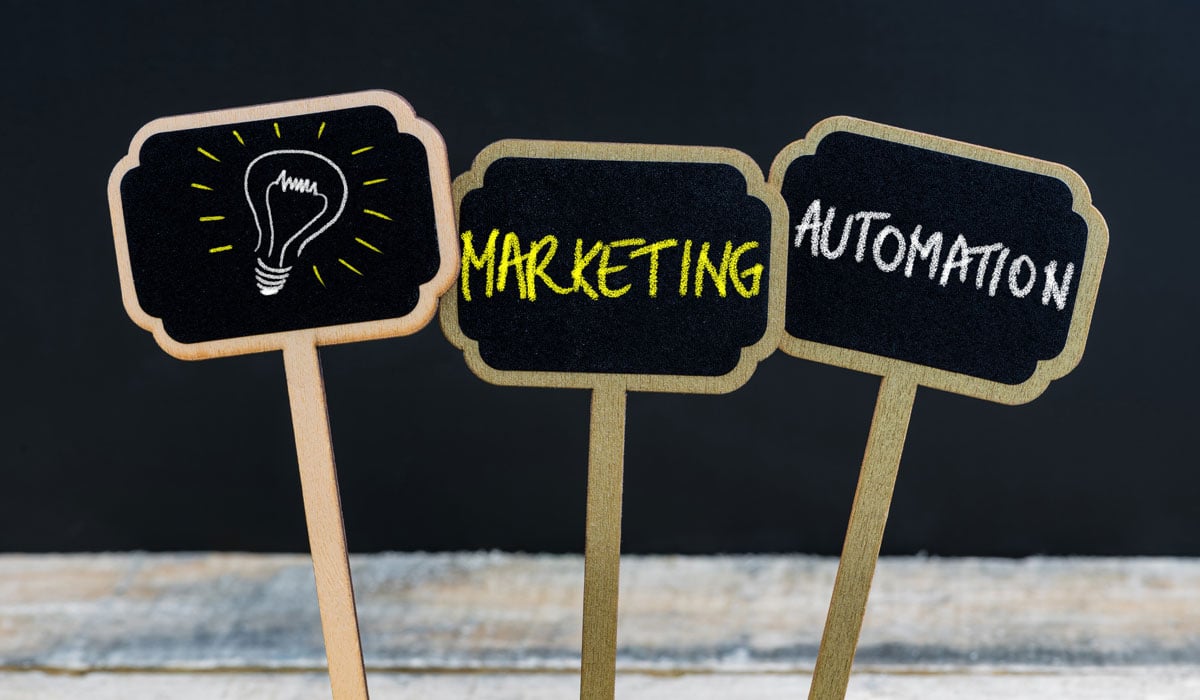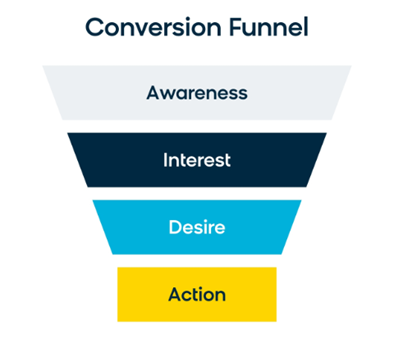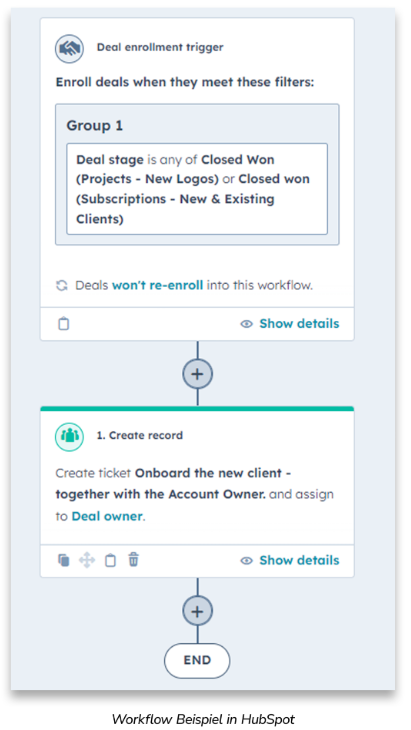Marketing automation has become an indispensable aid for many companies. This is because the technology combines the automation of processes with the ability to create and distribute highly personalised and relevant messages.

What is marketing automation?
Marketing automation refers to the use of specialised software to automate marketing processes and campaigns across various communication channels and make them more efficient. These channels include email, social media, websites and SMS.
With the help of a marketing automation solution, you can automate repetitive tasks, free up resources and at the same time ensure consistent and personalised communication with your customers, as the technology provides support in a wide range of areas:
- Data aggregation: Marketing automation tools collect and integrate information from various customer interactions, such as email opens, website visits, social media engagements and form submissions. This gives you a comprehensive collection of data that makes it easy for you to create a detailed profile of your customers.
- Target group segmentation: You can use the collected data to precisely segment your target groups. This means that it is possible to send specific messages and campaigns to different customer segments based on their behaviour, preferences and demographic data.
- Automated workflows: An essential part of marketing automation is setting up automated workflows. These workflows consist of a series of predefined actions that are automatically executed based on certain triggers. For example, a workflow can be set up to send a welcome email as soon as a new user signs up for the newsletter, followed by a series of emails providing further relevant content.
-
Multi-channel communication: Marketing automation enables you to send consistent and coordinated messages across different channels. This includes email marketing, social media posts, SMS and personalised content on websites. The ability to communicate across multiple channels ensures that your customers are reached with relevant information at the right time.
What advantages does marketing automation offer?
Marketing automation makes a significant contribution to ensuring that your company can achieve its marketing goals and maintain its competitiveness in a dynamic market environment. This is because automation allows you to ensure that marketing campaigns are consistent and coordinated - even if the number of customers and the complexity of the campaigns increase.
By automating repetitive tasks, you can significantly increase your efficiency. Marketing teams are able to focus more on strategic initiatives, resulting in higher productivity as creative and effective campaigns are easily and quickly thought through and implemented. This is especially crucial in a highly competitive environment where speed and precision are key.
Another significant benefit of marketing automation is the ability to personalise. With this technology, you can create highly personalised campaigns that are precisely tailored to the individual preferences and behaviours of your customers. This helps customers feel better understood and valued.
Lead generation and maintenance is also made considerably easier. By collecting and analysing data, you can better prioritise your leads and develop targeted campaigns that systematically guide leads through the buying process to conversion. Concentrate your efforts on the most promising leads and manage them more efficiently.
One thing is certain: Your company can use marketing automation to scale marketing activities and reach large customer groups efficiently - without sacrificing the quality of interactions. This is particularly useful for growing companies that want to expand their marketing efforts.
Application areas for marketing automation
You can use marketing automation in various areas, as the technology enables you to optimise your marketing strategies and maintain consistent and personalised communication with your customers.
Lead generation and nurturing
Automating processes to identify and nurture leads is one of the main applications of marketing automation. By using automation tools, you can identify potential customers, analyse their behaviour and guide them through the buying process. Pre-defined lead scoring systems evaluate leads based on their behaviour and interaction with your brand, allowing sales to prioritise the most promising contacts. Using Automated Nurture Campaigns, you can send relevant content to leads and help them make informed buying decisions - always based on their position in the buying process. This not only improves conversion rates, but also ensures more efficient utilisation of marketing resources.
E-Mail-Marketing
Email marketing is another important area of application for marketing automation. By automating the sending of emails based on predefined rules and customer behaviour, you can send personalised and relevant messages at the right time. This includes, for example, welcome emails, birthday greetings, transaction confirmations and follow-up campaigns. Automated email workflows can also be used for larger campaigns where a series of emails are sent to nurture leads and move them through the sales funnel.
Social Media Management
Marketing automation is also very useful in social media management. You can automate the scheduling and publishing of social media posts to share consistent and relevant content and increase engagement. You can schedule posts in advance and publish them automatically. In addition, by analysing social media data, you can better understand what content resonates with your target audience and adjust your strategies accordingly. The integration of social media management into the marketing automation platform enables centralised management of all marketing activities and better coordination of campaigns.
Customer Relationship Management (CRM)
The integration of marketing automation with CRM systems is a crucial step in managing customer relationships and data. This integration allows you to gain a comprehensive view of your customers and create personalised marketing campaigns. By connecting CRM and marketing automation systems, you can track and analyse all of a customer's interactions and transactions. This leads to better segmentation and more targeted campaigns. For example, it is possible to send automated follow-up emails based on past purchases or specific customer behaviour.
Web-Personalisierung
Marketing automation can also be used to personalise website content. Based on the behaviour and preferences of visitors, you can display dynamic content that is tailored to the specific interests and needs of each user. This includes personalised product recommendations, tailored offers and targeted messages. By personalising the website experience, your business can increase user engagement and increase the likelihood of conversions.
Analyse und Reporting
Another important area of application for marketing automation is analysis and reporting. Automation tools provide comprehensive analyses and reports that allow you to monitor and evaluate the performance of your marketing campaigns. By analysing KPIs such as open rates, click-through rates and conversion rates, companies can gain valuable insights into the effectiveness of their strategies and make data-driven decisions. This helps to continuously optimise marketing measures and maximise ROI.
Marketing automation: differences in the B2B and B2C sectors
Marketing automation is used in both the B2B and B2C sectors, but there are significant differences in the approach, objectives and tactics used. These differences result from the different buyer behaviour, decision-making processes and marketing strategies that prevail in the two sectors.
Key concepts of marketing automation
Although many different aspects of marketing and business development come together in marketing automation software, the entire process is driven by a few core concepts.
The conversion funnel
The conversion funnel is the process that a person goes through until they finally become a customer. Marketing automation helps you to turn these prospects into valuable leads. The conversion funnel can be divided into a few basic stages:

- Awareness: The potential buyer knows with certainty that the company, product or service exists. It is still too early for this person to make a decision, but they are already aware of the company/product/service.
- Interest: Not every website visitor feels the need to buy immediately. At this point, those who are interested will request a free trial, follow the company on social media channels or browse the company's blog.
-
Consideration: The person is now so familiar with your company that they like your service/product. However, it is still too early to make a purchase decision.
-
Action: This is the phase in which someone decides whether to convert or not. This phase ends with a purchase decision.
Ideally, once a customer has made a purchase, they will buy from the company again. However, people will also drop out of the conversion funnel, no matter how well it is constructed. At best, only one to five per cent of people who have passed through the conversion funnel will convert.
If someone flies out of the conversion funnel, this is known as churn. Some churn is unavoidable, but marketing automation helps to reduce this churn rate. By identifying the needs and interests of visitors, it is easier to provide them with valuable, customised content.
Workflows
Workflows are a central component of marketing automation and are used to automate and optimise complex marketing processes. They enable companies to carry out systematic and repeatable actions based on specific triggers and conditions. This enables you to scale your marketing activities while creating more relevant and effective campaigns.
 Automation of repetitive tasks: Workflows enable the automation of repetitive and time-consuming tasks such as sending emails, follow-up notifications and social media posts.
Automation of repetitive tasks: Workflows enable the automation of repetitive and time-consuming tasks such as sending emails, follow-up notifications and social media posts. - Lead generation and nurturing: Workflows help you to send automated emails and content based on the behaviour and interests of leads. For example, a workflow can be set up to send a welcome email as soon as a new lead registers, followed by further emails containing additional information and offers.
- Personalisation and segmentation: You can personalise and segment your communication. Set up workflows to send different messages based on user behaviour, preferences and engagement.
- Multi-channel marketing: Workflows make it possible to send consistent and coordinated messages across different channels. This includes email, SMS, social media and more. A well-designed workflow ensures that your customers are reached with relevant information at the right time via their preferred channel.
- Lead scoring and qualification: Workflows can automate lead scoring and qualification processes by assigning points to leads based on their interactions and behaviour. This scoring helps the sales team to identify and prioritise the most promising leads.
- Measure and analyse: Workflows provide you with valuable data and insights into the performance of marketing campaigns. By tracking and analysing the different steps within a workflow, you can identify which tactics are successful and which need to be adjusted.
- Customer experience and customer loyalty: By automating personalised messages and offers, you can continually engage and retain your customers, leading to increased customer loyalty and repeat business.
Feedback loops and metrics
Feedback loops and metrics show how effective the marketing automation strategy is. How a person converts, clicks through to your organisation's website, ignores an email, marks it as spam or unsubscribes from the email list tells you how certain people perceive your messaging. For example, when a message is sent to a contact, they respond. Even a non-response is a response that becomes part of the feedback loop.
The metrics should be constantly monitored to get a feel for these reactions. With the help of marketing automation, you can easily draw conclusions as to whether your marketing strategy is too aggressive or not, for example.
User Flows
While the conversion funnel is there to represent the process a person goes through to convert, user flows are a history of the webpages a person went through before taking action.
When traffic comes to your website from different sources, such as ads, social media and emails, it needs to be directed to webpages that make it easy for the user to take action. Different people have different needs depending on how they find the website. The barrier to action for these people must therefore be kept as low as possible.
A person who uses a long-tail keyword to find a webpage is more likely to convert than a person who arrives at the website via an ad. More information - e.g. in the form of downloads - must be provided for them.
Choosing the right solution
Marketing automation platforms offer a wide range of functions that are tailored to the different needs of companies. It is therefore essential that you identify your specific requirements and objectives in advance in order to select the right solution. The platform you choose should offer all the necessary functions to achieve your marketing goals. This includes email marketing, lead management, CRM integration, data analysis and personalisation. Pay attention to user-friendliness and easy integration with existing systems.
Here are some of the leading solutions on the market:
HubSpot: HubSpot is known for its ease of use and comprehensive features that support businesses of all sizes. The platform offers an all-in-one solution that includes CRM, marketing, sales and customer service. HubSpot allows users to easily create and manage campaigns, track leads and perform detailed analyses.
Salesforce: Salesforce is a powerful platform that offers integrated CRM and marketing automation capabilities. Ideal for large companies, Salesforce enables seamless integration of marketing and sales activities and offers advanced data management and personalisation features.
Adobe Marketo: Marketo specialises in extensive automation and personalisation options and is particularly suitable for medium-sized to large companies. The platform offers advanced functions for lead management, email marketing and campaign analyses that help companies to optimise their marketing strategies and improve conversion rates.
How to introduce marketing automation in your company
The introduction of a marketing automation strategy is always a multi-stage process that requires careful planning and coordination and therefore an enormous amount of expertise. Precise groundwork and proper implementation are the be-all and end-all here:
- Define goals: The first step in introducing a marketing automation strategy is to define clear and measurable goals. These goals should be specific, measurable, achievable, relevant and time-bound (SMART). Typical goals could be to increase lead generation, improve customer retention or increase conversion rates. Setting clear goals helps to measure the success of the automation strategy and optimise performance over time.
- Analyse requirements and needs: Before selecting a marketing automation platform, you should conduct a thorough analysis of your requirements and needs. This includes evaluating your current marketing processes, identifying bottlenecks and determining the features you need from a marketing automation platform. This analysis will help you select the platform that best fits your specific requirements.
- Selecting the right platform: Choosing the right marketing automation platform is crucial to the success of your strategy. Consider factors such as functionality, ease of use, integration options and cost. Conduct thorough research, read reviews and, if possible, run trials to check the suitability of the platform for your needs. Popular platforms include HubSpot, Salesforce and Marketo.
- Integration with existing systems: Successful implementation of marketing automation requires seamless integration of the new platform with your existing systems such as CRM, CMS and other marketing tools. This integration enables a holistic view of your customers and ensures that all data and processes are harmonised. Make sure your IT department is involved in this process to overcome technical challenges and ensure a smooth integration.
- Cleanse and enrich data: The quality of your data plays a crucial role in the success of your marketing automation strategy. Make sure your data is accurate, complete and up-to-date before you go live with the platform. Perform thorough data cleansing and enrich your data to enable effective segmentation and personalisation. Regular data checks and updates are also important to ensure long-term data quality.
- Create workflows and campaigns: Create automated workflows and campaigns based on your defined goals and the needs of your target audiences. This can include email workflows, lead nurturing campaigns, trigger-based actions and more. Make sure your workflows are well thought out and aligned with the different stages of the customer journey. Test your workflows thoroughly before going live to ensure they work as planned.
- Team training and support: Successful implementation of marketing automation requires that your team understands and can effectively utilise the new tools and processes. Invest in comprehensive training programmes to ensure that all users are familiar with the features and benefits of the platform. Provide ongoing support and training to encourage user adoption and optimise the use of the platform.
- Continuous monitoring and optimisation: After implementation, it is important to continuously monitor and optimise the performance of your marketing automation campaigns. Use analyses and reports to gain insights into the effectiveness of your campaigns and make data-based decisions. Conduct regular A/B tests to optimise different elements of your campaigns and achieve the best results. Continuously adjust your strategies based on the insights gained to maximise ROI.
Challenges when implementing a marketing automation solution
Although marketing automation offers numerous advantages, you face a number of challenges during implementation that need to be considered and thought through. These challenges relate to the complexity of the implementation, the quality of the data and the need for cross-departmental collaboration.
Complexity
The introduction of marketing automation can be complex and costly. This technology requires a clear strategy and the right setup to be successful. You should ensure that you have the necessary infrastructure and expertise to use the technology effectively. If you don't have the necessary know-how or experience internally, be sure to seek external help from specialised agencies.
Selection and integration
Choosing the right marketing automation platform is a critical first step, but integrating this platform into existing systems and processes can also be challenging. It requires a deep understanding of the technical requirements and careful planning to ensure that the implementation goes smoothly and that all necessary functionalities are covered. In addition, you may need to invest in training and education to ensure that your teams can use the new tools and processes effectively.
Data sources and data quality
The quality of customer data plays a crucial role in the success of marketing automation. Incomplete or inaccurate data can significantly impact the effectiveness of campaigns. You need to ensure that your data is regularly reviewed and cleansed to ensure it is accurate and up to date. This requires the implementation of robust data management processes and systems.
The data must not only be accurate, but also comprehensive enough to provide meaningful insights. The challenge is to integrate and harmonise information from different sources to get a complete picture of customer interactions. In addition, your data management must comply with applicable data protection laws and regulations to minimise legal risks.
Cross-departmental collaboration
Effective utilisation of marketing automation requires collaboration between different departments, especially marketing, sales and IT. Everyone involved needs to be on board and working together to ensure that the automation strategy is implemented seamlessly. This can be a challenge as different departments often have different goals, processes and priorities.
A successful implementation of marketing automation therefore requires clear communication and coordination between the teams. It is important to define common goals and ensure that everyone involved understands the benefits and requirements of the new technology. Regular meetings and workshops can help to promote awareness and collaboration. In addition, dedicated project teams or task forces can be formed to manage the implementation and ensure that all aspects of automation are considered.
Technological integration
Another obstacle to the implementation of marketing automation is the integration of the new systems with existing technologies and platforms. Many companies use a variety of software solutions that often do not communicate seamlessly with each other.
The challenge is to ensure that the marketing automation platform is compatible with existing CRM systems, databases and other marketing tools. A lack of integration can lead to data silos and information gaps, which can impact the efficiency and effectiveness of automation strategies. Again, be sure to get external help if you don't have it yourself.
User acceptance and training
Even if the technology is implemented correctly, the success of marketing automation can depend on how well employees accept and utilise the new tools. The introduction of new technology can always be met with resistance, especially if your employees are used to the old processes and systems.
It is crucial that your company invests in training programmes to ensure that all users understand the features and benefits of the new systems. In addition, you should provide ongoing support to encourage user adoption and ensure teams are utilising the technology effectively.
Cost efficiency
The implementation of marketing automation inevitably incurs costs - not only for the purchase of the software, but also for implementation, integration and training. A clear cost-benefit analysis is necessary to ensure that the investment in marketing automation is profitable in the long term. Be sure to take into account possible hidden costs, such as ongoing maintenance and updates of the software. Nevertheless, a successful implementation offers significant benefits that justify the effort and investment.
Planning and measuring the return on investment (ROI) of marketing automation
Planning and measuring the ROI of marketing automation is critical to assessing the value and effectiveness of this technology for your organisation. A well thought out approach will help to justify the investment and make continuous improvements.
How to plan the ROI
- Set goals: The first step in planning ROI is to define clear and measurable goals. These goals could include increasing lead generation, improving conversion rates, increasing customer loyalty or reducing marketing costs.
- Record costs: It is important to consider all costs associated with the implementation and use of marketing automation. This includes the acquisition costs for the software, implementation costs, employee training and ongoing maintenance costs.
- Create forecasts: Based on the defined goals and recorded costs, you should create forecasts to estimate the potential ROI. These forecasts should be realistic and based on historical data and industry benchmarks.
How to measure ROI
- Identification of the key performance indicators (KPIs): In order to measure ROI, suitable KPIs must be defined. Important KPIs include the number of leads generated, the conversion rate, the customer acquisition cost (CAC), the customer lifetime value (CLV) and the total revenue generated by marketing automation.
- Data analysis: Collect and analyse data continuously to monitor the performance of your marketing campaigns. Marketing automation tools offer extensive reporting and analysis functions that provide insights into the effectiveness of your strategies. Compare actual results with forecasts to evaluate success.
- Continuous Optimization: Based on the analysis results, continuous optimizations should be made. Identify areas that can be improved and adjust your campaigns accordingly. A/B testing is an effective method to test different approaches and identify the best strategies.
Thought Leader Systems – Your Partner for a Successful Marketing Automation Strategy
With our comprehensive expertise and many years of experience, Thought Leader Systems guides you towards a more efficient and effective marketing strategy. Our team of seasoned specialists possesses deep knowledge in all areas of marketing automation, from planning to implementation.
Together, we analyze your individual needs and business goals to develop a tailored solution perfectly suited to your company. We employ cutting-edge tools and techniques and collaborate with leading partners to guarantee the highest quality and the best ROI for you.
The benefits of partnering with Thought Leader Systems include:
- Individual Consulting and Concept Development: We create a customized concept tailored to your specific requirements and objectives.
- Comprehensive Implementation Support: We assist you throughout the entire implementation process, from selecting the right software to integrating it into your existing systems.
- Training and Education for Your Employees: We ensure your employees are optimally trained and can effectively use the marketing automation solution.
- Continuous Optimization and Success Measurement: We support you in the ongoing optimization of your campaigns and measure the success of your marketing automation activities.
Take the next step towards a future-orientated and data-driven marketing strategy and rely on a professional and results-oriented partnership with Thought Leader Systems. Get in touch with us!

